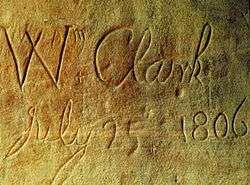Pompeys Pillar National Monument
| Pompeys Pillar National Monument | |
|---|---|
|
IUCN category III (natural monument or feature) | |
 | |
| Location | Yellowstone County, Montana, USA |
| Nearest city | Billings, MT |
| Coordinates | 45°59′43″N 108°00′21″W / 45.99528°N 108.00583°WCoordinates: 45°59′43″N 108°00′21″W / 45.99528°N 108.00583°W |
| Area | 51 acres (21 ha)[1] |
| Established | January 17, 2001 |
| Visitors | 50,000 (in 2002) |
| Governing body | U.S. Bureau of Land Management |

Pompeys Pillar National Monument is a rock formation located in south central Montana, United States. Designated a National Monument on January 17, 2001, and managed by the U.S. Bureau of Land Management, it consists of only 51 acres (21 ha), making it one of the smallest National Monuments in the U.S. It was previously designated a National Historic Landmark on July 25, 1965.[2] The new Pompeys Pillar Interpretive Center opened in 2006. Exhibits in the 5,700-square foot center relate the journey of Captain William Clark and his detachment, including Sacagawea and her son Pomp, down the Yellowstone River Valley in 1806.
The pillar itself stands 150 feet (45 m) above the Yellowstone River and consists of sandstone from the late Cretaceous Hell Creek Formation, 75 – 66 million years ago. The base of the pillar is approximately 1 acre (0.4 ha).
The pillar features an abundance of Native American petroglyphs, as well as the signature of William Clark, co-leader of the Lewis and Clark Expedition. Clark's inscription is the only remaining physical evidence found along the route that was followed by the expedition.
The inscription consists of his signature and the date, July 25, 1806.[3] Clark wrote that he climbed the sandstone pillar and "had a most extensive view in every direction on the Northerly Side of the river". He named the outcropping after Jean Baptiste Charbonneau—the son of expedition member Sacagawea—whom he nicknamed "Pompy". His original name for it was "Pompys Tower"; it was changed to the current title in 1814.
Situated 25 miles (40 km) northeast of Billings, Montana, along Interstate 94, the pillar gets 50,000 visitors annually. Archeological evidence suggests that the outcropping has been witness to 11,000 years of human involvement in the area. Consequently, in addition to the pictographs and the signature of William Clark, hundreds of other people have carved their initials into the rock, including early pioneers to the area.

See also
References
- ↑ "National Monument detail table as of April 2012" (PDF). Bureau of Land Management. Retrieved 2012-12-27.
- ↑ "Pompey's Pillar". National Historic Landmark summary listing. National Park Service. Retrieved 2007-06-28.
- ↑ Winser, Henry Jacob; Riley, William C. (1897). The Official Northern Pacific Railway Guide: For the Use of Tourists and Travelers Over the Lines of the Northern Pacific Railway and Its Branches. Northern Pacific Railwa. p. 151.
External links
| Wikimedia Commons has media related to Pompeys Pillar National Monument. |
- "Welcome to Pompeys Pillar National Monument". U.S. Bureau of Land Management. Retrieved 2006-08-13.
- "Pompeys Pillar National Monument". National Landscape Conservation System. Retrieved 2006-08-13.
- "Pompeys Pillar National Monument". The Wilderness Society. Archived from the original on 2006-07-10. Retrieved 2006-08-13.
- "Pompeys Pillar National Monument". Pompeys Pillar Historical Association. Retrieved 2006-08-13.
| ||||||||||||||||||||||||||||||||||||||||||||||||||||||||||
| ||||||||||||||||||||||||||